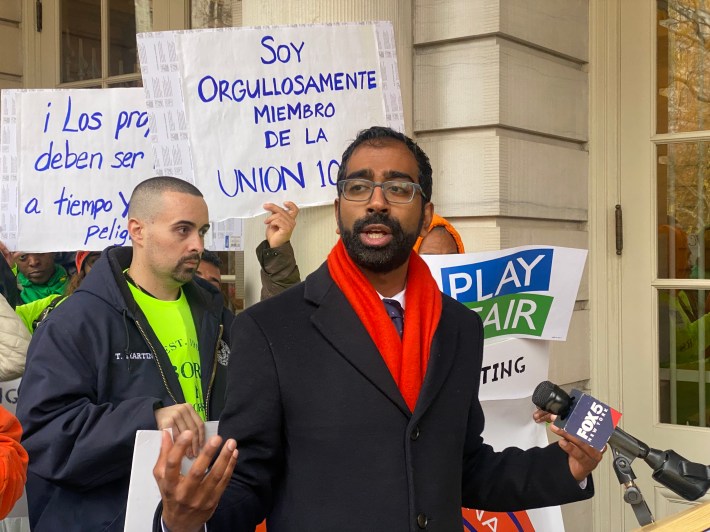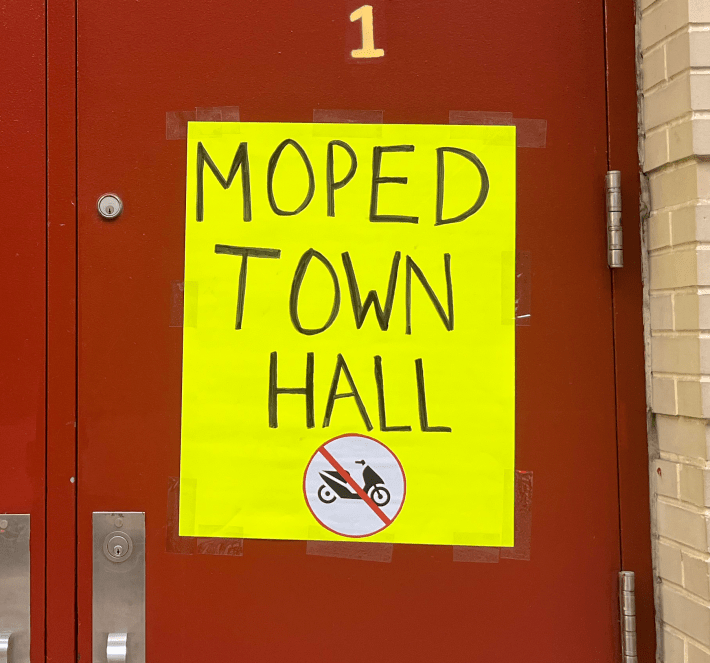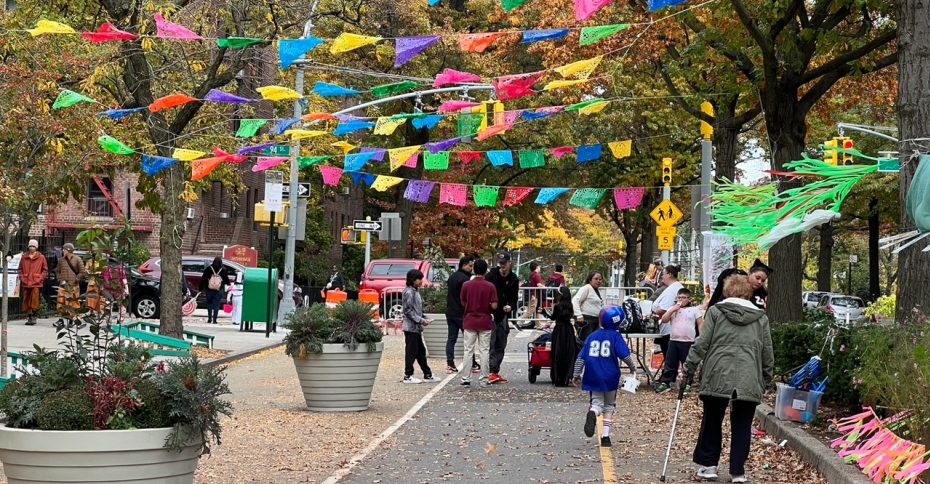The Department of Transportation put pedestrians in danger by not properly designing its so-called "gold standard" open street to keep out illegal mopeds, a pro-open street City Council member from Queens angrily declared.
At an epic "Moped Crisis" town hall last month, Council Member Shekar Krishnan said the 34th Avenue open street that he long championed is now a "moped highway" — and he blamed the DOT for the chaos while he contorted the purpose of the town hall to bash the agency before a packed crowd of agency opponents.
“Let me ask you this, 'How many of you all feel that the moped crisis is a problem that needs to be solved now, today?'” Krishnan asked, referring only to 34th Avenue, not the city as a whole.
The full auditorium erupted in cheers.

The DOT has allocated the considerable sum of $89 million for a permanent redesign of the 34th Avenue open street, which has been known as Paseo Park after the agency initially transformed the 26-block, car-light stretch between the Brooklyn-Queens Expressway and Junction Boulevard into a more tranquil place with several plaza blocks that are entirely car-free.

But the design includes painted bike lanes that are frequently used by riders of illegal mopeds, including delivery workers who feel unsafe on parallel avenues such as Northern Boulevard and 35th Avenue. The painted lanes zig-zag through the park, even through the plaza blocks.
Krishnan said this design makes it dangerous — though he declined to provide a plan that he thinks would be better.
"[Paseo Park's] confusing design, with bike lanes crossing through the middle of pedestrian plazas and bike stamps in the middle of shared streets, communicates that the space does not prioritize pedestrians," Krishnan told Streetsblog in a statement.
He specifically said he doesn't like that the bike lane often runs down the middle of the street and that pedestrians and cyclists are confused about where they should be, despite ample signage.
“There needs to be a design that safely separates speeding vehicles — cars or otherwise — from people. The Department of Transportation should create safe corridors for moped riders that do not cut through recreational spaces for families," said Krishnan in a statement to Streetsblog.
He wants a redesign — stat.
“Take it from a council member who funds capital projects. That is a lengthy lengthy process that takes years,” Krishnan said at the town hall.
The Department of Transportation defended the design of Paseo Park, as well as its upcoming capital project, which kicks off with a visioning session on June 18.
Hey Queens! Take our survey to help inform the future capital project vision of the 34th Ave Open Street: https://t.co/syQg96R9w2 and join us for a design workshop:
— NYC DOT (@NYC_DOT) May 23, 2024
When: June 18, 5-7PM
Where: IS 145 (33-35 80th St) pic.twitter.com/7EFpZ5anNg
"Thirty-fourth Avenue represents a world-class redesign that has transformed a typical city street into a community hub where residents, families, and school children can safely spend time together, play with one another, and enjoy community programming," a spokesperson told Streetsblog.
The moped town hall
Many attendees of the moped crisis event believed it would be a broad discussion about illegal mopeds and, indeed, fliers for the event said nothing of Paseo Park, or of DOTs involvement. Nonetheless, Krishnan steered the meeting toward the Transportation Department and its Commissioner Ydanis Rodriguez, and kept it focused on 34th Avenue.
Supporters of the 34th Avenue open street said their neighborhood oasis is the least of the larger problem.

“We never heard that the meeting was to discuss 34th Avenue, it was kind of a betrayal,” said Cristina Furlong, a Jackson Heights resident and a founding member of Make Queens Safer, which advocates for pedestrian safety and livable streets.
Furlong added that the focus solely on 34th Avenue, which has already received substantial city investment, ignores the larger Jackson Heights/Corona area, where there are major mobility and parks issues.
“It’s a disservice to be so narrow in focus,” Furlong told Streetsblog. “This council district is densely populated [so for the larger issues] to be ignored is frustrating."
DOT staffers, including Queens Borough Commissioner Nicole Garcia, gave a lengthy presentation describing the larger state of the city’s fight against illegal mopeds, which has included a 400-percent increase in seizures, the Post reported.
Paseo Park: The Gold Standard
Krishnan was elected in 2021 on a platform of turning the scrappy pandemic-era 34th Avenue open street into a permanent “linear park” and he has worked with the DOT since Paseo Park’s conception. When the agency presented to the community board in 2022 their plans to make the park permanent, Krishnan was thrilled.

“This design improves pedestrian safety and expands accessibility for all people,” he told Streetsblog after that presentation.
Crashes declined dramatically and crashes involving pedestrians dropped by 61 percent, the DOT said.
But at the town hall, Krishnan's tone shifted, with the Council member calling Paseo Park a “moped highway" instead of “26 blocks of joy” that he fought to create.
That said, so far this year, there have been nine reported crashes on Paseo Park. Just one of those crashes resulted in pedestrian injury, when a "motorcycle" collided with two pedestrians at around 9 p.m., injuring them both in February. In the same period in 2019, before there was an open street, there were 20 total reported crashes resulting in six pedestrian injuries, according to data compiled by NYC Crash Mapper.
“The biggest problem that we have is poor design by the DOT. The DOT wants to build on that poor design to do even more poor design,” said Krishnan.
Attendees agreed.
“The 34th Avenue open street is suffering an identity crisis,” said Andrew Ronin, a lifelong Jackson Heights resident who testified at the town hall. “Seven mopeds passed me on my walk here, in 15 minutes.”

Mopeds are already banned from the park and "NO MOPED" signs are in place at several intersections. At the same time, moped riders, who are mainly delivery workers, say they choose to cram into safe bike infrastructure because they feel unsafe when they ride in lanes with cars.
Mopeds do go fast — according to the DOT, the average speed is 17 miles per hour, which is far above the 5 mph standard for open streets. But the agency also shared sensor data at the town hall that showed that the majority of moped users in Paseo Park enter the park after 9 p.m. suggesting those passing through are delivery workers headed home.
But an illegal moped is still an illegal moped, even if it is using the roadway after hours. The department said the local 115th Precinct has issued 137 moving violations and seized 30 illegal devices in Paseo Park since May 20.
The Three E's
Vision Zero is built on three pillars: education, enforcement and engineering. But many people who say they are street safety advocates have focused only on enforcement as the solution to dangerous streets.
Like Krishnan, Assembly Member Jessica González-Rojas declined to focus solely on police presence, given that most moped users are workers trying to make a living.
“Of the 'Three E’s,' engineering is the most successful in a justice problem. We must design the roads to ensure that mopeds are not getting on [Paseo Park], and are not driving recklessly,” she said.
This morning, we joined @NYCMayor Adams at the Staten Island Landfill to send a message:
— Edward A. Caban (@NYPDPC) June 5, 2024
If you operate an illegal motorbike, dirt bike, moped, scooter, or ATV on a NYC street, you will be stopped and the NYPD will seize the vehicle. If it’s not legally owned, we will destroy… pic.twitter.com/tPn2D0iJVC
Nonetheless, the Adams administration continues to prioritize enforcement as the main tool to curb illegal moped usage. On Wednesday, the mayor staged yet another press conference bulldozing seized illegal mopeds next to NYPD Commissioner Edward Caban.
“NYPD has seized 13,000 of these vehicles since January, 7,500 of which have been destroyed,” said Caban.






